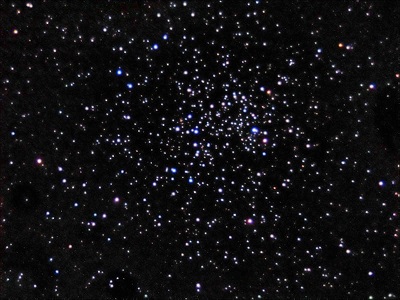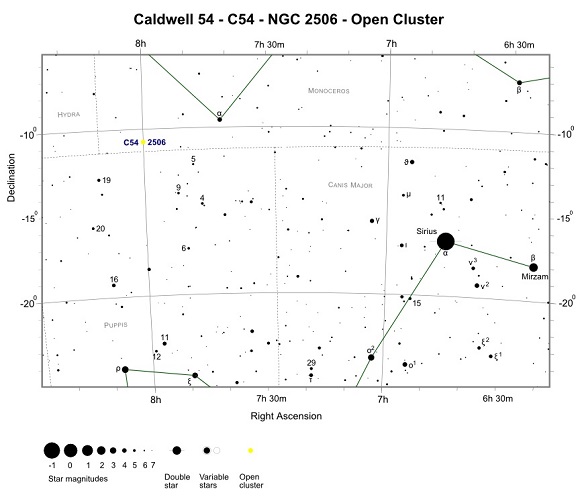NGC 2506 is a magnitude +7.6 rich open cluster located in the constellation of Monoceros. Although its member stars are faint the cluster itself appears quite bright and can be seen with a pair of binoculars. Through telescopes it's an impressive object and of all the Monoceros open clusters it's probably the finest. With an age of 1.1 billion years old this is an old cluster. For comparison, M45 (The Pleiades) in Taurus is a youthful 115 million years old with the Hyades cluster 625 million years old. However, NGC 2506 is not nearly as old as the 4 billion years of M67 in Cancer.
William Herschel discovered NGC 2506 on February 23, 1791. Locating the cluster can sometimes be a bit tricky as it's positioned in an area of sky devoid of bright stars. It can be found 5 degrees east-southeast of alpha Mon (α Mon - mag. +3.94) the brightest star in Monoceros. Located 19 degrees southwest of NGC 2506 is the brightest star in the sky, Sirius (α CMa - mag. -1.46). Although α Mon and Sirius are the brightest stars in their respective constellations the difference in apparent brightness between them is enormous, more than 100x.
Large open cluster M48 lies 6 degrees northeast of NGC 2506 with open cluster pair M46 and M47 positioned 6 degrees southwest of NGC 2506. They are best seen during the months of December, January and February.


Finder Chart for C54 - NGC2506 - pdf format
NGC 2506 appears as a faint small misty unresolvable patch of light in 7x50 or 10x50 binoculars. A 100mm (4-inch) telescope under dark skies reveals about a dozen stars embedded in hazy, misty patch of light. Through 200mm (8-inch) scopes, NGC 2506 is a wonderful sight. At high magnifications more stars are visible, arranged in chains streaming across the face of the cluster. The brightest member stars are of magnitude +10.8 and the cluster contains at least 150 stars packed in an apparent diameter of 7 arc minutes. A 300mm (12-inch) scope resolves many more stars with NGC 2506 appearing more compact at the edges than in the centre. This is a wonderful object and a superb cluster for amateur astronomers, especially those with medium or larger sized scopes.
C54 Data Table
| Caldwell | 54 |
|---|---|
| NGC | 2506 |
| Object Type | Open Cluster |
| Constellation | Monoceros |
| Distance (ly) | 11,300 |
| Apparent Mag. | +7.6 |
| RA (J2000) | 08h 00m 02s |
| DEC (J2000) | -10h 46m 11s |
| Apparent Size (arc mins) | 7.0 x 7.0 |
| Radius (light-years) | 12 |
| Age (years) | 1.1 Billion |
| Number of Stars | 150 |
| Other Name (s) | Collinder 170, Melotte 80 |